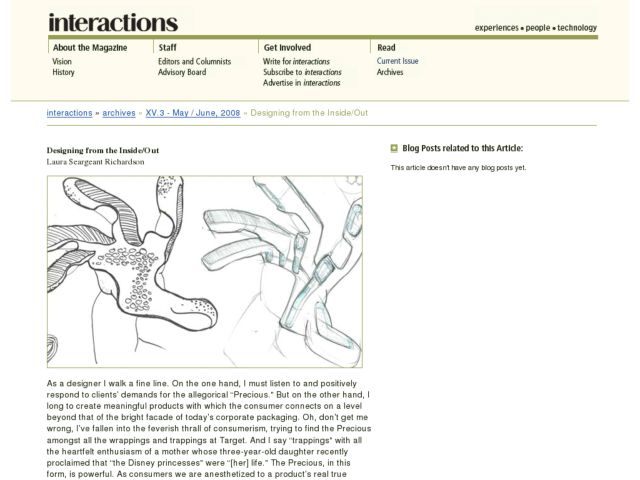Laura Richardson writes in interactions magazine, May/June 2008 (subscription required for full text) about a philosophy of industrial design whose goal is to "get to the heart of the matter—meaningful interactions at the core of great product design." In a sense, I can boil this down to needs. People have needs, explicit and unexpressed, that have to be described in relation to your product. The successful products are those where the flow between need and fulfillment are fluid and natural.
This design philosophy is based on the idea that the experience with the product necessarily connects the user's desire or impetus for use with the manifestation and interaction with the product. Designing towards these goals is not simply a matter of form following function, but, more importantly, relating to desire and emotion. "Form ... is designed to interact, reflect, and engage with the interior as well as the external audience."
Inside-Out design considers interior issues such as purpose/function, desire, and emotion on one hand. On the other hand, it thinks about the exterior elements of form, interfaces, physical use, possibilities and limitations of the medium. The resulting experience—the outcome of I-O design—reflects the process of designing the product to reflect elements of the interior. Richardson goes on to describe the process used for doing I-O design of a smarter driving glove that produces better feedback, and a medical ID that considers the emotional needs of those who need them.
All projects must start with understanding the fundamental goals and desires driving the reason for the product's existence. What Richardson is exposing in the examples is the process that led to solutions. It's really like the unfolding of a story. It starts with an expression of fundamental desires, talks about how the desires need to touch the product, continues with designers aware of these internal needs making sure they are met, and ends with people using the product to meet their needs. Oh, and somewhere afterward, someone makes money off the process. :)
Designers of web sites and applications who invest any time in user research, and factor this information into the design process, are already engaged in this type of activity. We have good examples of how rich applications have innovated the web with AJAX, for example. One example that comes to mind are interfaces that use AJAX to focus on efficiency when the primary need is to get things done. Or controls that anticipate what your next step will be, depending on the context of your actions. The innovation comes in the form of re-thinking what could conventionally be done, or what could be created to feel cool, and instead focussing what can be made to get to the heart of what user's desire, and what their emotional needs are.
The thrust of the article is that some industrial design has, in recent years, fetishized the package to the detriment of the experience. Designers can avoid that trap by re-focusing on interior needs.
